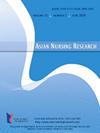对阻塞性睡眠呼吸暂停患者进行基于自我效能的干预:系统回顾。
IF 2.1
3区 医学
Q2 NURSING
引用次数: 0
摘要
目的:本研究旨在系统回顾针对阻塞性睡眠呼吸暂停(OSA)患者的基于自我效能的干预措施,并确定提示自我效能的常用技术数量与主要结果变量之间的关系:本系统综述根据 PRISMA 指南进行。方法:本系统性综述按照 PRISMA 指南进行,分析了针对 OSA 患者使用基于自我效能干预的实验研究。系统检索了 EMBASE、CINAHL、PubMed、SCOPUS 和 Web of Science 五个数据库中截至 2023 年 12 月发表的文章。根据行为改变技术(BCT)分类法和自我效能理论来源对干预措施进行分类,并进行叙述性综合:在所评估的 6968 篇文章中,有 11 篇文章被纳入分析(1304 名参与者)。结果表明,在所分析的研究中,最常使用的BCT是 "指导如何实施行为"、"暴露 "和 "社会支持"。关于技巧的数量,在自我效能感有显著改善的研究(5 项)中,平均使用了 6.0 种 BCT(范围为 4-8)和 3.2 种理论来源(范围为 2-4),而在自我效能感相关结果为零的研究(6 项)中,平均使用了 4.8 种 BCT(范围为 2-5)和 2.8 种理论来源(2-3):本综述强调了基于自我效能的干预措施在治疗 OSA 方面的潜力,并为设计有效的干预措施提供了坚实的理论基础。此外,研究结果表明,利用更多样化的BCT和理论来源可能有助于提高自我效能干预的有效性。因此,临床医生应考虑将各种行为改变技术和自我效能理论中的四种自我效能提示来源纳入干预措施中,以提高OSA患者的自我效能,进而提高其治疗依从性:前瞻性系统综述注册(CRD***********)。本文章由计算机程序翻译,如有差异,请以英文原文为准。
Self-efficacy-based Interventions for Patients With Obstructive Sleep Apnea: A Systematic Review
Purpose
This study aimed to systematically review self-efficacy-based interventions for patients with obstructive sleep apnea (OSA) and identify the relationship between the number of used techniques for prompting self-efficacy and the main outcome variables.
Methods
This systematic review was conducted in accordance with the PRISMA guidelines. Experimental studies on the use of self-efficacy-based interventions for patients with OSA were analyzed. Five databases, EMBASE, CINAHL, PubMed, SCOPUS, and Web of Science, were systematically searched for articles published until December 2023. Interventions were classified based on the behavior change technique (BCT) taxonomy and the theoretical sources of self-efficacy to conduct a narrative synthesis.
Results
Of the 6,968 articles evaluated, 11 were included for analysis (1,304 participants). The results showed that the most frequently employed BCTs in the analyzed studies were “instruction on how to perform a behavior,” “exposure,” and “social support.” Regarding the number of techniques, an average of 6.0 BCTs (range, 4–8) and 3.2 theoretical sources (range, 2–4) were utilized in studies that showed significant improvements in self-efficacy (5 studies), whereas an average of 4.8 BCTs (range, 2–5) and 2.8 theoretical sources (2–3) were used in studies that indicated null results related to self-efficacy (6 studies).
Conclusion
This review underscores the potential of self-efficacy-based interventions in the management of OSA and provides a solid theoretical foundation for designing effective interventions. Additionally, the results indicate that utilizing a greater diversity of BCTs and theoretical sources may contribute to the effectiveness of self-efficacy interventions. Therefore, clinicians should consider incorporating various behavior change techniques and four sources of prompting self-efficacy from self-efficacy theory into interventions to enhance self-efficacy, and consequently, treatment adherence in patients with OSA.
求助全文
通过发布文献求助,成功后即可免费获取论文全文。
去求助
来源期刊

Asian Nursing Research
NURSING-
CiteScore
4.20
自引率
4.50%
发文量
32
审稿时长
45 days
期刊介绍:
Asian Nursing Research is the official peer-reviewed research journal of the Korean Society of Nursing Science, and is devoted to publication of a wide range of research that will contribute to the body of nursing science and inform the practice of nursing, nursing education, administration, and history, on health issues relevant to nursing, and on the testing of research findings in practice.
 求助内容:
求助内容: 应助结果提醒方式:
应助结果提醒方式:


